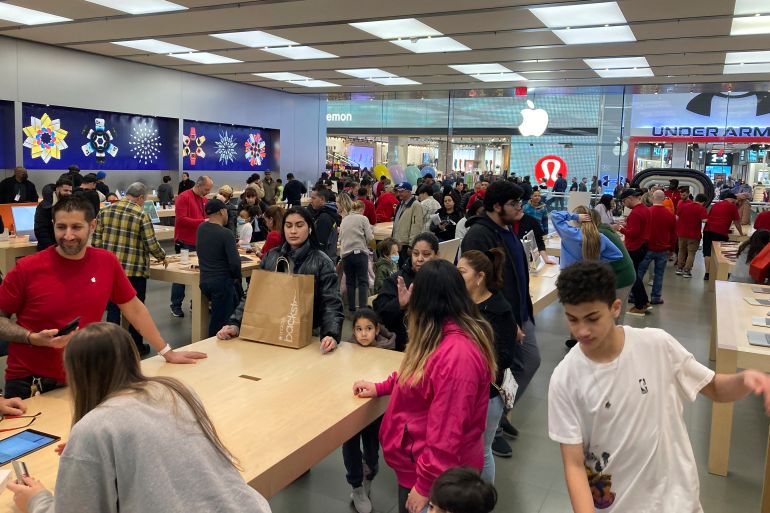US retail sales fall more than expected in December
The broad drop in sales together with subsiding inflation should lead to a slowdown in the pace of interest rate hikes.

United States retail sales fell more than expected in December, pulled down by declines in purchases of motor vehicles and a range of other goods, putting consumer spending and the overall economy on a weaker growth path heading into 2023.
Broad drops in sales reported by the US Department of Commerce on Wednesday, together with subsiding inflation, are likely to encourage the Federal Reserve to further scale back the pace of its interest rate increases next month. The US central bank is engaged in its fastest rate hiking cycle since the 1980s.
Keep reading
list of 4 itemsSenior UN officials in Afghanistan to press for women’s rights
Microsoft to lay off 10,000 people, increasing job cuts in tech
US professor sues university over Prophet Muhammad image row
“Weak retail sales in December shows consumers are likely retrenching during a time of economic uncertainty,” said Jeffrey Roach, chief economist at LPL Financial in Charlotte, North Carolina. “The trajectory for the US economy is weakening and recession risks are rising for 2023.”
Retail sales fell 1.1 percent last month. Data for November was revised to show sales dropping 1 percent instead of 0.6 percent as previously reported. It was the second straight monthly decline. Economists polled by Reuters had forecast sales decreasing 0.8 percent. Retail sales rose 6 percent year-on-year in December.
Retail sales are mostly goods and are not adjusted for inflation. December’s decline in sales was likely in part the result of goods prices falling during the month. Holiday shopping was also pulled forward into October as inflation-weary consumers took advantage of discounts offered by retailers.
Higher borrowing costs as the Federal Reserve battles inflation are also weighing on retail sales as goods tend to be financed on credit. Retail sales were also likely hurt by a cold snap in December as well as lower prices for gasoline or petrol, which impacted receipts at service stations.
In addition, spending is shifting back to services.
Sales at auto dealers fell 1.2 percent. Receipts at service stations tumbled 4.6 percent. Online retail sales dropped 1.1 percent. Furniture stores sales plummeted 2.5 percent. Receipts at food services and drinking places, the only services category in the retail sales report, fell 0.9 percent.
Electronics and appliance store sales declined 1.1 percent. Clothing store sales fell 0.3 percent. There were also decreases in receipts at general merchandise stores.
But sales at sporting goods, hobby, musical instrument and bookstores edged up 0.1 percent. Receipts at building material and garden equipment suppliers rose 0.3 percent.
The Fed last year raised its policy rate by 425 basis points from near zero to a 4.25 percent – 4.5 percent range, the highest since late 2007. In December, it projected at least an additional 75 basis points of hikes in borrowing costs by the end of 2023.
Excluding automobiles, petrol, building materials and food services, retail sales fell 0.7 percent last month. Data for November was unrevised to show these so-called core retail sales sliding 0.2 percent as previously reported.
Core retail sales correspond most closely with the consumer spending component of gross domestic product. The weakness in core retail sales is likely to be offset by anticipated gains in services spending. Consumer spending continues to be underpinned by labour market tightness, which is keeping wages elevated.

Lower momentum
With inflation-adjusted consumer spending increasing 0.5 percent in October and being unchanged in November, economists believe growth in overall consumer spending in the fourth quarter would exceed the 2.3 percent annualized rate logged in the third quarter.
Gross domestic product growth estimates for the October-December quarter are as high as a 4.1 percent rate, also reflecting the sharpest contraction in the trade deficit in November since early 2009. The economy grew at a 3.2 percent rate in the third quarter.
Nevertheless, consumer spending and the overall economy are entering 2023 with less momentum. Savings are also dwindling.
Most economists expect the economy will slip into recession by the second half of the year, though there is cautious hope that moderating inflation could discourage the Fed from raising interest rates significantly higher. This would result in growth only slowing sharply rather than the economy contracting.
News on inflation continued to be encouraging. A separate report from the US Department of Labor on Wednesday showed the producer price index (PPI) for final demand decreased 0.5 percent in December after rising 0.2 percent in November.
In the 12 months through December, the PPI increased 6.2 percent after climbing 7.3 percent in November. Economists had forecast the PPI dipping 0.1 percent on the month and gaining 6.8 percent year-on-year.
The report came on the heels of reports last week that monthly consumer prices fell for the first time in more than 2 1/2 years in December.
A 1.6 percent decline in the prices of goods accounted for the drop in the PPI. Goods, which gained 0.1 percent in November, were pulled down by a 7.9 percent plunge in energy and a 1.2 percent drop in food prices.
Services prices edged up 0.1 percent after rising 0.2 percent in November.
Excluding the volatile food, energy and trade services components, producer prices gained 0.1 percent in December. The core PPI advanced 0.3 percent in November.
In the 12 months through December, the core PPI rose 4.6 percent after increasing 4.9 percent in November.